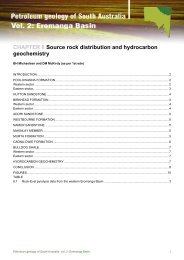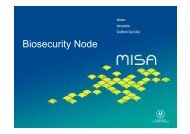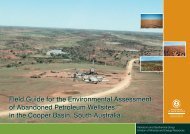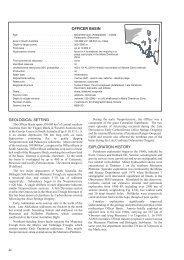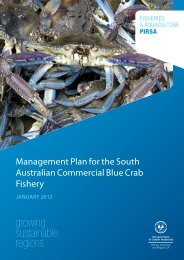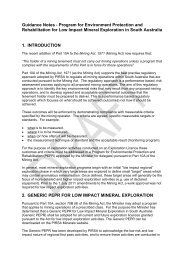Petroleum geology <strong>of</strong> South Australia. Vol. 4: Cooper Basin.The arrangement when Delhi joined the search in May1958 was for it to be the operator <strong>of</strong> the geophysical <strong>and</strong>geological work, to drill two deep wells (one each in SouthAustralia <strong>and</strong> Queensl<strong>and</strong>) <strong>and</strong> to acquire a 50% interest in ageological, seismic <strong>and</strong> drilling program (spending at least£2 million over the ensuing four years) in the licence area.The company formed Delhi Australia Petroleum <strong>and</strong> openedan <strong>of</strong>fice in Adelaide. Its combination with Santos becameknown as Delhi–Santos. The partnership also looked forextra financial assistance: Frome-Broken Hill’s earlier lack<strong>of</strong> success in South Australia had not deterred its hopes <strong>and</strong>the company joined Delhi–Santos as an equal partner inMarch 1959. This method <strong>of</strong> a licensee farming-out areas toothers prepared to farmin to a joint arrangement waslegislated for in 1958. Amendments to the Petroleum Act,which were to favour Santos <strong>and</strong> Delhi, also allowed thecreation <strong>of</strong> a chequerboard system through which licenceareas could be subdivided so that other companies couldparticipate. The time for working the new blocks wasextended from one to five years. Frome-Broken Hill’sfarmin agreement was a temporary one under which it was topay for the drilling <strong>of</strong> three wells in South Australia <strong>and</strong>Queensl<strong>and</strong> to earn a one-third interest in OELs 6 <strong>and</strong> 7.The Mines Department undertook seismic investigationsin largely unknown s<strong>and</strong> covered areas near Innamincka,which had become a ghost town by 1954 because <strong>of</strong> adecline in the pastoral industry, <strong>and</strong> into South-WestQueensl<strong>and</strong> from August 1958 to May 1959 for Delhi.Playford had acceded to Delhi’s request to improve <strong>and</strong>exp<strong>and</strong> the seismic operation prior to this survey. Thedepartmental seismic crew was contracted by Delhi to shoottraverses across <strong>and</strong> along the Innamincka Dome <strong>and</strong> aregional traverse from Innamincka via Cordillo to Betoota.The department supplied the technical staff under theleadership <strong>of</strong> K.R. Seedsman <strong>and</strong> B.E. Milton, seismicequipment, caravans <strong>and</strong> two drills while Geosurveysprovided non-technical services, carrying facilitiesincluding double-decker buses, a drill <strong>and</strong> other equipmentto fulfil the logistical requirements <strong>of</strong> the survey. Using theadvice <strong>of</strong> Geosurveys, Santos selected a drill site 35 kmnortheast <strong>of</strong> Innamincka. The Strzelecki Track, a formerstock route which had petered out after the 1930s depressionbecause <strong>of</strong> a lack <strong>of</strong> water bores, was then built by thegovernment over the 460 km from Lyndhurst to Innaminckato allow the area to be serviced by vehicles involved in the<strong>petroleum</strong> search (Donovan <strong>and</strong> Donovan, 1996).The Premier <strong>and</strong> the Minister attended the peggingceremony at Innamincka in February 1959 <strong>and</strong> drillingcommenced at the end <strong>of</strong> March. Innamincka 1, the firstwell to drill through the Cooper Basin <strong>and</strong> to penetrate thefull Eromanga Basin sequence, was completed to 3852 m byNovember. It reached gently dipping Ordovician beds(which were assigned questionably to the Devonian at thetime <strong>and</strong> for the next 30 years) <strong>and</strong> revealed thin Permiansediments beneath a thick Triassic sequence. Oil <strong>and</strong> gasprospectivity was suggested by minor hydrocarbon shows insediments within the Mesozoic succession. Thirty-fivecores were taken during the drilling <strong>and</strong> ten drillstem testswere run. These provided evidence <strong>of</strong> gas with water <strong>and</strong>oil-cut mud in the Permian <strong>and</strong> Mesozoic which encouragedfurther <strong>exploration</strong>.The Delhi–Santos search also included areas inSouth-West Queensl<strong>and</strong> where Santos held ~175 084 km 2under Authorities to Prospect 66P <strong>and</strong> 67P around HaddonCorner. In 1958 the companies proposed that the SouthAustralian <strong>and</strong> Queensl<strong>and</strong> governments consider the areasin the two States as one <strong>exploration</strong> prospect: the whole areaunder consideration was larger than the State <strong>of</strong> Texas(Australasian Oil <strong>and</strong> Gas Journal, 1958). OELs 6 <strong>and</strong> 7 inSouth Australia expired in February 1959 <strong>and</strong> were reissuedas OELs 20 <strong>and</strong> 21 (~457 520 km 2 ). Delhi–Santos’s interestin the Cordillo Downs area had led to access roads beingbuilt together with an airstrip at Haddon Downs for largeraircraft. In the event, the companies could not achieve theirGeosurveys adapted double-decker buses as mobile camps for itsfield survey parties: this bright yellow one was the kitchen at theInnamincka camp in 1958. (Photo T001671)Drilling Innamincka 1. (Photo T001689)20
Petroleum geology <strong>of</strong> South Australia. Vol. 4: Cooper Basin.The drilling crew was running joints <strong>of</strong> pipe into the hole inrapid succession as they prepared to conduct a drill-stemtest on the Innamincka No. 1 exploratory well in SouthAustralia. Engrossed in their work, they paid scantattention to a man sitting on an apple box next to the drilleron the derrick floor.But the man’s eyes were glued on the crew as they loweredmore <strong>and</strong> more lengths <strong>of</strong> pipe into the hole. Suddenly, amessenger ran up <strong>and</strong> said: ‘It’s dinnertime, Sir Thomas.’Thus Sir Thomas Playford, Premier <strong>of</strong> South Australia,arose from his apple box <strong>and</strong> journeyed to the camp for hisevening meal. But as soon as he finished eating he wastedno time getting back to his favourite perch.‘It’s quite a bit different from putting down a percussiondrilled water well on my fruit orchard,’ he observed.The Premier’s vigil on the apple box at Innaminckasymbolized the interest <strong>of</strong> people all over Australia inDelhi’s exploratory drilling program in the vast, primitive,outback region. The Great Artesian Basin lies underneaththis area <strong>of</strong> Central Australia.Sir Thomas Playford’s personal interest in the oil search impressedDelhi as the company’s magazine indicated admiringly(Delhi-Taylor Oil Corporation, 1960, p.8).aim to work their holdings as a whole: the <strong>exploration</strong> <strong>and</strong><strong>development</strong> programs were operated <strong>and</strong> reported to therespective governments independently. But in 1960 theSouth Australian Mines Department participated in drillingBetoota 1 in Queensl<strong>and</strong>. That well went through the samesequence as at Innamincka but on the flank <strong>of</strong> a structure <strong>and</strong>it ran into a conglomerate so the well was stopped.Frome-Broken Hill withdrew from its farmout agreementwith Delhi–Santos after Betoota 1.THE BREAKTHROUGHDiscoveries <strong>of</strong> oil <strong>and</strong> gas in the first half <strong>of</strong> the 1960s inQueensl<strong>and</strong>, the Northern Territory, Western Australia <strong>and</strong><strong>of</strong>fshore Victoria continued to encourage speculators,investors <strong>and</strong> companies. The general mineral boom <strong>of</strong> thatdecade brought many large <strong>and</strong> small overseas <strong>and</strong>Australian companies onto the <strong>petroleum</strong> scene. Forexample, Sprigg with others formed <strong>and</strong> promoted BeachPetroleum in 1960 <strong>and</strong> later held licences in the NorthernTerritory <strong>and</strong> elsewhere. In 1962 H. Harvey (a Santosdirector since 1957) arranged for Total Exploration, asubsidiary <strong>of</strong> the French Petroleum Co. (Australia), to inject£800 000 into Delhi–Santos by purchasing one millionshares. More foreign <strong>and</strong> interstate capital came to the foreafter a gas discovery was made in 1963: Burmah Oil, forexample, joined in the search in 1965. The StateGovernment readily accepted that foreign capital <strong>and</strong>imported technology <strong>and</strong> expertise were necessary in thesearch <strong>and</strong> <strong>development</strong> phases.From 1960 the aeromagnetic <strong>and</strong> gravity surveys becamebetter organised <strong>and</strong> more systematic. New seismictechniques <strong>and</strong> technologies <strong>and</strong> <strong>exploration</strong> strategies in theindustry led the Mines Department to exp<strong>and</strong> its operationsto focus on ‘s<strong>of</strong>t rocks’ for <strong>petroleum</strong>. Its geophysicistsworked in the vicinity <strong>of</strong> Birdsville from July to November1960 <strong>and</strong> work was carried out at Durham Downs <strong>and</strong>Innamincka Dome for Delhi between August <strong>and</strong>We got to the point below the water-bearing s<strong>and</strong>stonewhere we hit a lot <strong>of</strong> hard red rock ... an ominous sign. TheDirector was coming into my room the moment any corearrived <strong>and</strong> chewing his fingernails. Playford waspersonally very interested in what went on. When they hitthe red rock they thought they had hit bedrock. I didn’tknow either because I didn’t know what went on below theJurassic s<strong>and</strong>stone. I wrote to a friend [Dorothy Hill <strong>of</strong> theDepartment <strong>of</strong> Geology at the University <strong>of</strong> Queensl<strong>and</strong>]<strong>and</strong> said, ‘Could you send me some samples down urgently<strong>of</strong> what you are drilling through in Queensl<strong>and</strong> in thesequence?’ She sent me down a selection <strong>of</strong> relevantspecimens <strong>and</strong> that was all I had to go by, what they weredrilling through below the aquifer s<strong>and</strong>stone. I looked atthe samples <strong>and</strong> thought, ‘This is not bedrock.’ I didn’tknow quite what it was. The Director was in my room atthe time <strong>and</strong> he was very distressed to know whether wewere in bedrock <strong>and</strong> I said, ‘Hold your horses, we are not inbedrock yet’, so he went <strong>of</strong>f. And then we ran into coal farbelow that, which made it even funnier. That coal wasprobably Permian, so we were well above bedrock.Finally we went through the coal, unknown sections, <strong>and</strong>we went into some other very hard rock. Red. Red isusually the bad sign, because it is not very marine. Isuddenly recalled that I had seen some red s<strong>and</strong>stones verysimilar to this in samples <strong>of</strong> Devonian from western NewSouth Wales. I thought, ‘Someone has got to saysomething or someone around the place will have a stroke,so I will make a stab at it.’ So I said to the Chief Geologist[Tim O’Driscoll], ‘I think we are in the Devonian because Ihave just been picking through the cuttings <strong>and</strong> I think Isaw some shelly bits that remind me <strong>of</strong> some bits I saw inthe Devonian rocks from western New South Wales.’ Sothey remained in that rock, nobody had a stroke, <strong>and</strong>eventually they just drilled on <strong>and</strong> on; it was still in thesame formation so they eventually decided to stop thebore ...They accepted the fact that it was Devonian ... Afterwards Imodified it a bit to say it could be Cambrian because wehave got some Cambrian red beds out on the eastern side <strong>of</strong>the Flinders Ranges. It could be those but that is the onlyalternative. But it is not Precambrian <strong>and</strong> it is not all thatold, just hard.The experienced departmental palaeontologist, Dr Nell Ludbrook,describing the excitement associated with drilling the wildcatInnamincka 1 well (O’Neil, 1989b). Zang (1992) <strong>and</strong> Cooper(1986) have shown this to be Ordovician.November. A field party continued seismic shooting fromBirdsville to Marree at the end <strong>of</strong> May 1961. The search wasencouraged by the news in December 1961 <strong>of</strong> the discovery<strong>and</strong> potential <strong>of</strong> the Moonie oil field in Queensl<strong>and</strong>, whereAustralia’s first production <strong>of</strong> oil in commercial quantitiesbegan in 1964 (Wilkinson, 1988).The results <strong>of</strong> the department’s seismic surveys in thenortheast between 1960 <strong>and</strong> 1964 helped to define structuraltrends in the Cooper Basin <strong>and</strong> were particularly importantin identifying the Gidgealpa–Merrimelia–Innamincka(GMI) Ridge, with the consequential discovery <strong>of</strong> naturalgas. But ultimately the situation developed to the stagewhere the department could not justify undertaking workwhich contract seismic crews should have been doing at thatstage <strong>of</strong> <strong>exploration</strong>. As the expense <strong>of</strong> continuallymodernising the department’s equipment was not justified,after 1964–65 its operations were scaled down <strong>and</strong> the21










